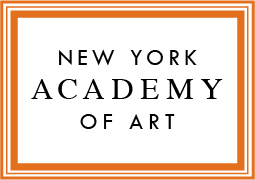by Claire Cushman (MFA 2015)
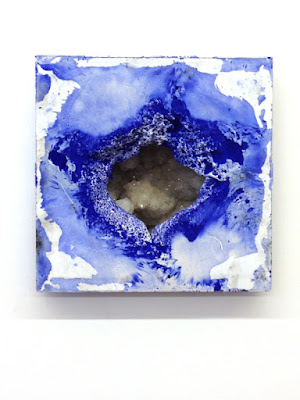 |
| Ruptured Slab: hydrocal, spray paint transfer, dry pigment, calcite geode (2015) |
I first met Sarah Elise Hall (MFA 2009) two and a half years ago, in Toronto, where we are both from. I was painting out of a shared studio space, and Sarah happened to stop by to visit the space’s owner. When she mentioned that she had gone to the Academy, I excitedly told her I was applying for the following year.
Soon after, Sarah and I met for coffee. She told me all about her Academy experience, and helped me select images for my application. A few months later, when I was accepted to the school, she was very encouraging. Thankfully we’ve stayed in touch, and Sarah has been a kind and helpful mentor throughout my entire Academy experience.
This fall, when I was beginning to delve into abstraction, Sarah recommended I get a little crazy with my materials and media. “Use the most insane tools you can think of,” she told me. “Like, get a broom, put your canvas on the floor, and see what it’s like to paint with a broom. And really mess around with medium – pour a whole can of shellac over your oil paint. There are all these rules about ‘fat over lean,’ but see what happens if you completely disregard them.”
Unsurprisingly, this spring, Sarah was nominated for “Most Experimental Media.”
Sometimes, when something in a work of art isn’t working, all you really need to do is switch up your tools or medium to fix the problem. For example, brush size can make all the difference. Hall, who went through NYAA for sculpture, pushes materials to their limits. She’s been exploring themes of mortality and decay for about ten years now and is currently working with geodes and dry pigments to further this investigation. Her work was recently on display at Los Ojos in Brooklyn. Below, she answers some questions about her materials.
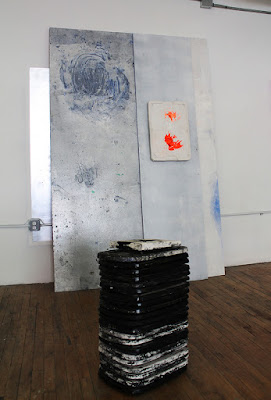 |
| System 2 (Grey Aggregate with Carbon Stack). Plywood, enamel floor paint, dry pigment, acrylic paint skins, hydrocal. |
What are you doing with geodes and dry pigment? How do these materials relate to your investigation of mortality and decay?
As my work has evolved, the expression of this idea (mortality and decay) has become progressively more abstract. The geodes and the cast dry pigment fit into a larger category of work called Cavities – ruptures in paintings, walls and sculptures. Cavities are about what’s inside or underneath a facade, surface or skin, and make me think of the body, urban decay such as sinkholes and dilapidated infrastructure, and hollowed-out spaces in nature such as caves and other geological formations. In my work, sometimes these ruptures are natural forms such as geodes, and sometimes they are hand made with cast forms that I sink into walls or paintings. Casting dry pigment is another way of creating an area of decay in a given form. Working with dry pigment and hydrocal is also a way for me to investigate new ways of painting.
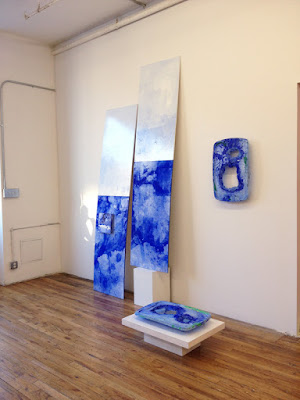 |
| System 1 (Ultramarine R7) plywood, enamel floor paint, dry pigment, spray paint transfer, hydrocal (2015) |
You majored in sculpture at NYAA, and now are working more with installation- What caused this shift? What information that you learned at the Academy have you held onto/let go of?
I don’t really see it as that much of a departure. I’ve studied both painting and sculpture, and what I’m doing now is a continued investigation of both, although I now consider the architecture I’m working within as well. My parameters have more to do with my ideas (memento mori) than with a specific form, and so this has allowed me to shift between medical imagery, the body, disease, contaminated landscapes, fossils, and decay within a form in a cohesive way. What I learned at NYAA was invaluable and in many ways is the backbone of my practice. I think the information and skill I acquired at the school will continue to resurface in my work in the future
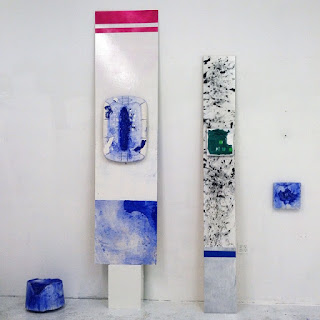 |
| Studio shot (untitled) – materials: plywood, enamel floor paint, dry pigment, acrylic paint skins, hydrocal (2015) |
in different ways.
You tend to shift around a lot in terms of media – how does this process of changing gears happen for you? How long will you stay in one medium/process before moving on?
I really like working with different materials as a way of expressing different ideas – materials have inherent meaning, and I like either pairing or juxtaposing materials with my overall concept. Materials are as much part of my visual language as my form sense, so I don’t really move on and leave something else behind. It’s more like expanding my language where at times I circle back and pick something up again if it serves a purpose.
What music do you listen to while you work?
That’s all over the place and not always music … Miles Davis, Dosh, New Order, Nine Inch Nails, NPR, Rachel Maddow… and sometimes nothing. Silence can be a good thing, especially in this city.
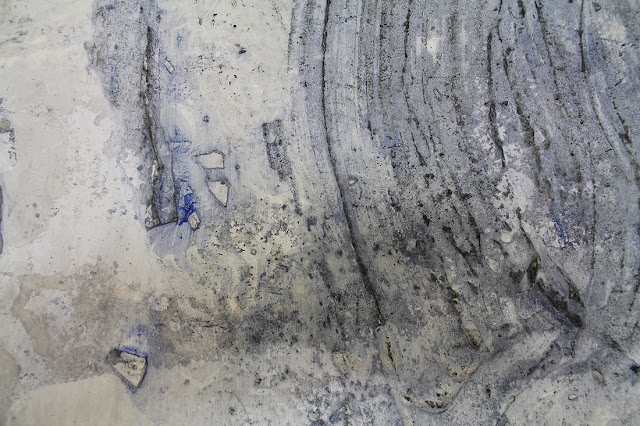 |
| Detail of Grey Aggregate (2015) |
